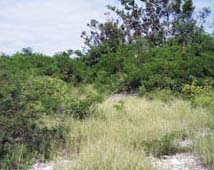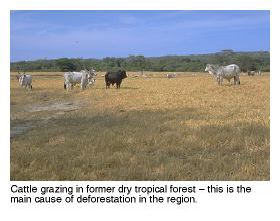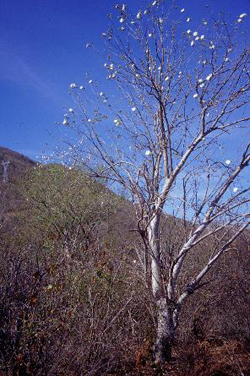The Dry Forest.
When most people think of the tropics, we think of the tropical rain forest. It may come as a surprise that for over 75% of the tropics, annual drought is a way of life. There are many different kinds of tropical habitat that experience dry seasons, with names like tropical dry forest, tropical deciduous forest, thorn forest, spiny desert, savannah, cerrado, and caatinga. Some of these habitats aren't so unfamiliar after all: most people have seen images of giraffes, zebras, and elephants congregating around African waterholes during a dry season, with flat- topped Acacias or baobab trees adding a strange air to the landscape. Savannah scenes like these are often from the Serengeti, Masai Mara, or Tsavo parks in eastern Africa. These places, which definitely aren't rainforest, are right on the equator. Despite being more extensive than rainforests, public awareness of tropical dry habitats is low and they receive little attention from conservation efforts. Dry areas of the tropics often have higher soil quality than tropical wet forest areas, making them better for agriculture. As a result, their degradation is far more advanced than that of wet forest. In addition, their contribution to humanity of such crops as maize -- the most important US crop -- is inestimable.
Tropical dry forests make up the majority of tropical forests on earth. Even though there is more dry tropical habitat throughout the world than rainforest, this habitat is not as well known and tends to be overlooked by conservation efforts. Dry forest, which runs from southern Sonora to Chiapas in México. This represents the largest extent of tropical dry forest north of the equator. The ever-changing landscape of the dry forest is a beautiful expression of its adapting nature to environmental changes. While this forest is well adapted to thrive through high temperatures and long droughts, it also plays a key role in regulating water runoff and protecting aquatic resources. The majestic jaguar and cougar, the river otter, the Mexican anteater and the rare pygmy skunk adorn the ephemeral beauty of dry forests. Because of their geographical and ecological isolation from other tropical forests, Mexico’s dry forests harbor high levels of endemism: 31% (246 species) of Mexico’s endemic species are found here. These forests were also the evolutionary origin of some very unique tree species, such as the Gliricidia sepium, which is now being used in other parts of the world for rapid reforestation.
In a tropical dry forest, the dry season is far longer than the
brief period of rainfall. Most of the trees and shrubs found in
this type of habitat are deciduous, losing their leaves at the onset
of the extended dry season, and for this reason they are also known
as tropical deciduous forests. In the Americas, vast tracts of tropical
dry forest once reached along the Pacific coast from the tip of
Baja California in the north to northern Argentina. Much of this
forest has been lost, but some still remains today in many rugged
mountainous areas, national parks, and biosphere reserves.
|



